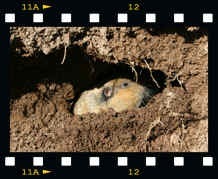
Gophers can destroy thousands of hours of hard work in establishing a landscape, and thousands of dollars in plantings, irrigation pipes, foundations, gazebos, and decks. Here are ten essential gopher control tips—the ten commandments of gopher control.
1. Always take care of gopher problems sooner rather than later.
Female gophers are able to reproduce before their first birthday. Under adverse conditions, each female gopher can bear 5 to 7 offspring once a year. Under ideal conditions, such as your irrigated and landscaped lawn, each female gopher can bear 5 to 7 offspring three times a year, each of its babies building tunnels through approximately 200 to 2000 square feet (20 to 200 square meters) of your lawn when it leaves its mother.
2. Stop gopher problems before they start.
Before you put out a collection of rare and expensive flower bulbs, make sure you keep gophers out. Don’t just dig in wire mesh around your flower beds. Put wire mesh underneath your flower beds, so there is no way gophers can burrow their way in.
3. Don’t sabotage gopher traps by contaminating them with your scent.
Sweaty palms transfer human scent to gopher traps. Especially if you tend to perspire, always wear cloth (not latex) gloves when you handle traps, both when you are putting them out and when you are removing gophers.
4. Make sure you have all legally required permits before you trap gophers.
Nearly all jurisdictions in the United States permit killing of gophers. To put out a kill trap legally, however, you may be required to get a written permit from your local fish and wildlife office or (in Canada) provincial natural resources office first. Don’t trap first and apply for permission later.
5. If you plan to do live trapping, make sure you have a place to release the gopher before you catch it.
It is important to have permission to release live gophers on public property or someone else’s private property. Even if you have another property on which to release gophers, you may be required to have a permit to transport the gopher from your home to your other property.
6. Remember that commercial gopher poisons usually work. Do-it-yourself gopher poisons usually do not.
In most states of the United States, it is possible to buy strychnine-laced alfalfa pellets to kill large numbers of gophers over a large landscape or small form. Once the gopher burrow is located, the pellets are placed in the main tunnel with an applicator and the tunnel is covered so surface animals (and people) are not put at risk. Agricultural supply stores and feed and seed stores sell the pellets and give you all the information you need to use the poison legally.
Automobile exhaust, rat poison, and similar methods, however, are difficult or impossible to use without considerable risk to the human putting out the poison, and typically don’t control gophers very well, or at all. Click the link here to read more about poisons and keeping pests under control.
7. Use sounds and odors to keep away gophers, but don’t use any method for more than a week or two.
Vibrating gopher stakes, pinwheels, fox urine crystals, mothballs, and the like can keep gophers away for a week or two. It is necessary to keep changing “gopher annoyance” methods weekly so you will slow down gopher activity.
8. Get all required permits before trapping gophers live.
Live trapping methods are usually permitted, but relocating gophers to another property usually is not.
Smaller Havahart traps (with no more than 5 inches/13 cm of clearance to avoid trapping skunks) can capture gophers for their later release unharmed. Some states permit release of gophers on public lands (although not city parks). Others permit release of gophers on your own property. And still others permit release of gophers elsewhere on your own property but not transporting them off your property, or require your obtain a written permit to transport gophers before you catch them.
9. Get all required permits before setting out snap traps for gophers.
Kill traps for gophers are usually legal, but may require written permits. In some states, the fish and game or wildlife commission requires a written permit before putting out kill traps for gophers. This is intended to ensure that gopher traps are not used above ground and do not endanger children or pets.
10. Don’t forget to destroy tunnels after you have gotten rid of gophers.
The overlooked gopher control tip is that failing to destroy gopher tunnels only invites a new group of gophers to set up housekeeping on your property. Fill in tunnels to prevent return of gophers and to keep snakes, skunks, rats, mice, beetles, and crickets from taking up residence in their place.

Leave a Reply